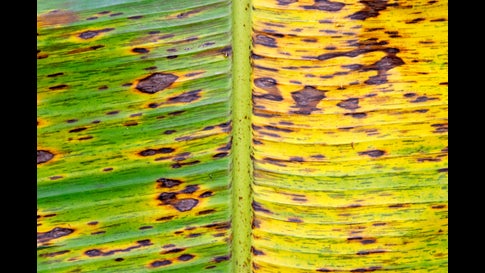Bananas threatened by climate-driven fungal disease, study says
by Pam Wright from The Weather Channel

A warming world is aiding the spread of a fungus that attacks banana plants, drastically reducing their output.
At a Glance
- The fungal disease has spread from Asia to the Caribbean and Latin America over the past six decades.
- Black Sigatoka, also known as ‘black leaf streak,’ can reduce fruit production on infected plants by up to 80 percent.
- New research says climate change has helped spread the disease.
The risk of a banana-attacking fungal disease is increasing in some areas due to climate change, new research says.
Black Sigatoka, also known as “black leaf streak,” has been on the move since the 1960s from Asia to areas now including the Caribbean, Latin America and most recently to parts of Florida.
The fungal disease can reduce fruit production on infected plants by up to 80 percent, according to a study published Monday in the journal Philosophical Transactions of the Royal Society B.
The research found that changes to moisture and temperature conditions as a result of climate change have increased the risk of Black Sigatoka by more than 44 percent in affected areas during the past six decades.
“Black Sigatoka is caused by a fungus (Pseudocercospora fijiensis) whose lifecycle is strongly determined by weather and microclimate,” lead author Daniel Bebber of the University of Exeter said in a press release.


The researchers analyzed experimental data on Black Sigatoka infections combined with detailed climate information over the past 60 years to reach their conclusions.
“This research shows that climate change has made temperatures better for spore germination and growth, and made crop canopies wetter, raising the risk of Black Sigatoka infection in many banana-growing areas of Latin America,” Bebber said.
While some banana-growing areas have become more prone to the fungus as global warming continues, other areas are seeing a reduced risk of the disease, the researchers found.
“Despite the overall rise in the risk of Black Sigatoka in the areas we examined, drier conditions in some parts of Mexico and Central America have reduced infection risk,” Bebber noted.
Black Sigatoka was first reported outside of Asia in Honduras in 1972. It then spread throughout Central America and eventually reached Brazil in 1998 and the Caribbean islands of Martinique, St Lucia and St Vincent and the Grenadines by the late 2000s, according to the press release.
More recently, the disease has been reported in banana-growing areas in parts of Florida.
“While fungus is likely to have been introduced to Honduras on plants imported from Asia for breeding research, our models indicate that climate change over the past 60 years has exacerbated its impact,” Bebber said.
The researchers did not attempt to predict what future climate change might mean for the spread of the fungus or the risk to future banana crops throughout the world.The Weather Company’s primary journalistic mission is to report on breaking weather news, the environment and the importance of science to our lives. This story does not necessarily represent the position of our parent company, IBM.
For more on this story go to: https://weather.com/science/environment/news/2019-05-08-bananas-threatened-climate-driven-fungus-climate-change





